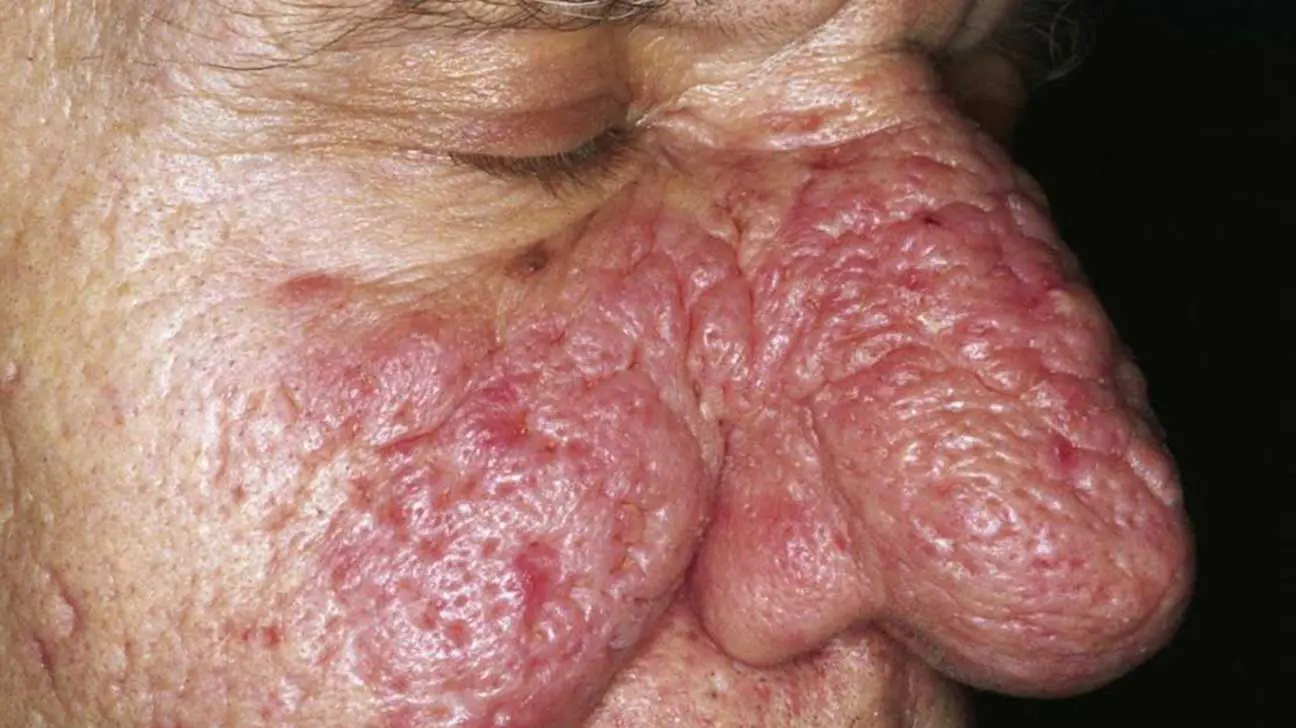What Is An Alcoholic Nose (Drinker’s Nose)?

Medically Reviewed By: Kimberly Langdon M.D.

An alcoholic nose, also known as a drinker’s nose, is characterized by a red, bumpy, and swollen nose.
It’s been a long-held belief that alcohol abuse causes this skin disease, but recent findings have revealed that this is actually a skin condition called rhinophyma.
What Is Rhinophyma?
Rhinophyma is a skin condition that causes a bulbous, bumpy, red-colored nose.
Though the causes of rhinophyma are unknown, it’s thought to be a severe form of a skin disease called rosacea.
Rosacea is caused by blood vessels swelling under the skin, causing red skin sores. These sores often look splotchy, have spider-like veins, or appear acne-like.
This is a very common skin condition that tends to emerge for weeks or months at a time. Experts have not yet identified where rosacea comes from.
Why Have People Associated Rhinophyma With Alcohol Abuse?
Alcohol abuse can cause red flushness in the face similar to the symptoms of rhinophyma, leading to confusion between the two.
Alcohol acts as a vasodilator, something that opens up the blood vessels. This allows blood to travel more easily through the vessels, causing a flushed look in the face.
But a 2015 study from the University of South Florida Morsani College of Medicine proved that there is no connection between alcohol abuse and rhinophyma or rosacea.
The study surveyed a range of people with the skin condition and revealed that rhinophyma is found in just as many individuals who do not drink as in those who do drink.
If a person has rhinophyma, that is no indication as to whether they drink or abuse alcohol.
Does Alcohol Worsen The Effects Of Rhinophyma?
Another common reason why this skin condition has been called alcoholic nose is that if a person has this condition, drinking alcohol can cause flare-ups.
If a person has an existing rhinophyma condition, alcohol may aggravate it.
A few things that can cause aggravation to rhinophyma include:
- drinking alcohol, specifically red wine
- extreme heat or cold
- spicy foods
- hot drinks
- blood-dilating drugs, such as blood pressure medications
- some makeup
Symptoms Of Alcoholic Nose
The most noticeable symptom of rhinophyma is swelling and redness of the nose and face.
Redness can spread anywhere across the body but is commonly found on the face, shoulders, ears, and chest.
Other symptoms include:
- enlarged pores
- thick skin
- swelling
- redness and patchiness
- dry or oily skin
- bumps
These symptoms can be treated with antibiotics such as tetracycline, metronidazole, and erythromycin. There is no cure for rhinophyma.
Who Is Susceptible To Developing Alcoholic Nose?
There are certain groups of people who have ethnic or genetic backgrounds to make them more susceptible to alcoholic nose than others.
A few of these factors include:
- being male
- having fair skin
- being middle-aged
- having a family history of rhinophyma or rosacea
- being of English, Scottish, Scandinavian, or Eastern European descent
Managing The Effects Of Rhinophyma
Alcohol is not the cause of alcoholic nose, but it does have an effect on those with rhinophyma.
For those who have rhinophyma, here are tips for alcohol consumption:
- avoid red wine
- limit alcohol consumption
- add water, soda, or lemonade to alcoholic beverages to dilute the alcohol content
Eliminating The Stigma Behind Alcoholic Nose
Because for so many years people have assumed a connection between alcoholism and rhinophyma, a stigma has formed around the idea of an alcoholic nose.
There are many who live with rhinophyma who do not drink and don’t want to be associated with alcohol abuse.
For those who have the skin condition, it can be difficult to enter into society when flare-ups occur because of the existing stigma surrounding alcoholic nose.
This is a stigma, however, that those who struggle with substance abuse regularly face.
As friends and family members to those with substance use disorders, we can learn about the warning signs of addiction, talk more openly about topics of addiction, and offer support.
Treating Alcohol Use Disorder
If you or a loved one are in search of treatment services for alcohol use disorder, help is available.
There is a range of treatments to choose from, such as long-term recovery plans, inpatient or outpatient treatment, 12-step programs, aftercare, and more.
Call our helpline to talk to one of our trained representatives who can help to guide you toward the right addiction treatment center for your or your loved one.
- American Academy of Dermatology Association (AAD) — Triggers Could Be Causing Your Rosacea Flare-ups https://www.aad.org/public/diseases/rosacea/triggers/find#:~:text=Anything%20that%20causes%20your%20rosacea,%2C%20alcohol%2C%20and%20spicy%20foods.
- Mayo Clinic — Vasodilators https://www.mayoclinic.org/diseases-conditions/high-blood-pressure/in-depth/high-blood-pressure-medication/art-20048154#:~:text=Vasodilators%20are%20medications%20that%20open,more%20easily%20through%20your%20vessels.
- U.S. National Library of Medicine: MedlinePlus — Rosacea https://medlineplus.gov/ency/article/000879.htm
- U.S. National Library of Medicine: MedlinePlus — Rhinophyma https://medlineplus.gov/ency/article/001037.htm
